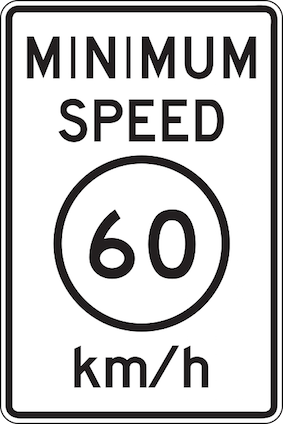
We can’t stress it enough: to beat the GRE, you have to understand how to make the design of its questions and its structure work for you.
In this article, I lay out the overall GRE exam pattern and marking scheme. Then, I go through it section by section, giving you a detailed look at the skills and knowledge that’s tested, and the different types of questions you’ll face. Finally, I have great tips on how you can best use all this info on test day.
Why Study the GRE Exam Pattern?
If you understand the design of the questions on the GRE, you can maximize your score by using the standardized format of the test to make your life easier rather than harder.
Focus your studying. By only working on content that you need to know from the GRE test pattern, you won’t waste time studying what isn’t covered. For example, the Verbal Reasoning section heavily tests vocab, but doesn’t test grammar, so your prep time should be focused on boosting your work knowledge.
Prepare the best strategies. Many test-taking techniques are format specific, so you should only practice strategies you can use on test day. For instance, the GRE lets you mark and review questions. This means you can make several passes through each section, solving questions in order from easiest to most difficult.
Manage your time wisely. On test day, you won’t waste valuable time trying to puzzle out how questions are worded or presented. Instead, you’ll use your time to answer them.
Relieve exam day stress. You can stay calm knowing what to expect on test day in terms of logistics. For example, since you know you’ll get scratch paper from the proctor, you won’t worry about where you can take notes.
Quick side note: we've created the world's leading online GRE prep program that adapts to you and your strengths and weaknesses. Not sure what to study? Confused by how to improve your score? We give you minute by minute guide.
You don't NEED a prep program to get a great GRE score. But we believe PrepScholar is the best GRE prep program available right now, especially if you find it hard to organize your study schedule and don't know what to study.
Click here to learn how you can improve your GRE score by 7 points, guaranteed.

GRE Pattern Overview
Before I lay out the question design and marking scheme of each part of the GRE, let’s go over the pattern of the test as a whole.
Please note: this guide focuses on the computerized version of the GRE, since almost 98% of GRE test-takers use this version of the test. (For more info on the paper GRE, see the end of this section.)
What Are the Sections of the GRE?
The GRE consists of three section types.
The first section of the GRE is always Analytical Writing, which gives you two 30-minute blocks to write two essays: “Analyze an Issue” and “Analyze an Argument.”
The next five sections are in random order. They include two sections of Verbal Reasoning and two sections of Quantitative Reasoning. Each Verbal Reasoning section is 30 minutes long and has 20 multiple choice questions testing your vocabulary and reading comprehension. Each Quantitative Reasoning section is 35 minutes long and has 20 multiple-choice and free-response questions testing basic algebra and geometry.
There is also one section that doesn’t count toward your scores. This can be either a disguised (unmarked) experimental section or a clearly marked research section. The experimental section tests questions for future GREs and looks exactly like a Verbal or Quantitative section. It can appear any time after Analytical Writing, and there’s no way to know which section it is, so definitely do your very best on all sections you see. The research section might have questions with different formats or on other topics. If it appears, it will always be at the end of the test.
What Is the Marking Scheme of the GRE?
You get three scores on your GRE:
- An Analytical Writing score from 0–6, in half-point increments
- A Verbal Reasoning score from 130–170, in 1 point increments
- A Quantitative Reasoning score from 130–170, in 1 point increments
How is Analytical Writing scored?
Each GRE essay gets two raw scores. One score is from a specially trained reader, who uses a six-point scale to judge the overall quality of the essay. The other score is from an ETS computer program called e-rater, that evaluates writing proficiency.
For each essay, if the two scores are close, they are averaged into one individual essay score. If they aren’t close, then a second human reader rates the essay and the computer score is discarded. The two human scores get averaged into the individual essay score.
Finally, the two individual GRE essay scores are averaged together to get your GRE Analytical Writing section score.

How Are Verbal and Quantitative Sections Scored?
Within each Verbal and Quantitative section, your score is determined by the number of questions you get right. There is no penalty for wrong answers, so even if you don’t know anything about the question, you should guess.
For each of these sections, ETS first calculates your raw score – that’s how many questions you answered correctly. Then, your raw score is converted to a scaled score using a conversion formula that takes the difficulty of each question into account. This converted score is your section score.
The GRE Is an Adaptive Test
The Verbal and Quantitative sections change in difficulty depending on how well you’re doing. In other words, your first Verbal or Quantitative section is always medium difficulty. But then, your second section of that type will either be easy, medium, or hard, depending on how you did on the first one. This is probably different from other exam patterns you’ve seen in school on paper.
ETS uses this adaptive system to better measure the full range of your ability. By getting to questions which are more in line with your skill level faster, ETS can more accurately pinpoint exactly where you fall on the bell curve of test takers.
How Long Is the GRE?
The GRE is approximately 3 hours and 45 minutes long.
There are 1-minute breaks after each section and a 10-minute rest break after the third section. All breaks are optional. You can take them, or use only a part of each break and go on to the next section.
How Is the Paper GRE Different?
The paper GRE exam pattern tests the same content and is very similar in question design to the computer test.
It has five sections: it always starts with the Analytical Writing section, and then in any order has two Verbal Reasoning, and two Quantitative Reasoning sections. Analytical Writing section is made up of two 30-minute essays, each Verbal Reasoning section has 25 questions to be answered in 35 minutes, and each Quantitative Reasoning section has 25 questions to be answered in 40 minutes. There are no experimental or research sections on the paper GRE.
Overall, you’ll have about 3 hours 30 minutes for the paper GRE, with a 10-minute break after the second section.
Some questions formats will be somewhat different to accommodate the paper test. For example, there are no Select-In-Passage questions on the Verbal Reasoning sections, while on the Quantitative Reasoning section, you answer Numeric Entry questions by filling in circles on a bubble grid.
And finally, the paper test is not adaptive.

GRE Test Pattern: Analytical Writing
This section features two different essay questions.
“Analyze an Issue” Essay Question
For this essay, you will get a prompt consisting of two parts.
Want to improve your GRE score by 7 points? We have the industry's leading GRE prep program. Built by world-class instructors with 99th percentile GRE scores, the program learns your strengths and weaknesses through machine learning data science, then customizes your prep program to you so you get the most effective prep possible.
Try our 5-day full access trial for free:
First, a general statement positing a broad idea, policy, or issue (always from ETS’s list of general statements). Second, a writing prompt directing you to agree with, disagree with, or find some middle ground on the statement (always one of these prompts).
Your job is to write an essay that persuades someone else your position is right, using evidence and examples from current events, history, and your experience.
Here’s what a general statement is like:
All parents should be required to volunteer time to their children’s schools.
“Analyze an Issue” Essay Question Design
For this essay, you will also get a prompt consisting of two parts.
First, a paragraph-long argument proving or disproving a thesis with several pieces of evidence (always from ETS’s list of arguments). Second, a writing prompt directing you to analyze the weaknesses in the argument’s structure (always one of these prompts).
Your job is to examine problems with the argument’s logic, with its use of evidence, missing or incomplete information, and errors in its underlying assumptions.
This essay focuses on structure – you don’t need to know anything about the subject matter, and your essay should only concern itself with the presentation of the argument.
Here’s what an argument paragraph is like:
The following appeared in a letter to the school board in the town of Centerville.”All students should be required to take the driver’s education course at Centerville High School. In the past two years, several accidents in and around Centerville have involved teenage drivers. Since a number of parents in Centerville have complained that they are too busy to teach their teenagers to drive, some other instruction is necessary to ensure that these teenagers are safe drivers. Although there are two driving schools in Centerville, parents on a tight budget cannot afford to pay for driving instruction. Therefore an effective and mandatory program sponsored by the high school is the only solution to this serious problem.”
What Does the GRE Analytical Writing Section Look Like on the Screen?
The screen is divided in two: the prompt on the left and a blank space for your essay on the right. Here is what this looks like for the “Analyze an Issue” essay:
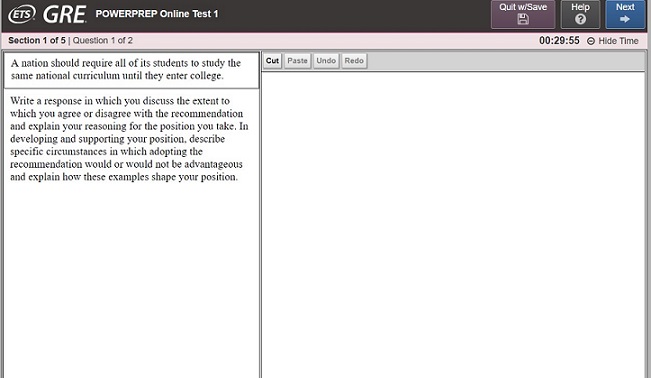
The basic text editor has buttons to cut and paste, and to undo and redo your previous action. There is no spellcheck functionality in this text editor. Minor and infrequent spelling errors will not count against you, but you should minimize them through proofreading.
You will also see a clock counting down the amount of time left in the section.
The “Next” button takes you to the next essay, so do not press it unless you are 100% sure you are done with the essay you are working on. The “Help” button shows instructions for the Analytical Writing section – you shouldn’t ever have to press this button.

GRE Test Pattern: Verbal Reasoning
Each of the two Verbal Reasoning sections contain three types of questions.
10 questions on each section are on vocab: Text Completion questions ask you to pick the right words to fill blank spaces left in a sentence, and Sentence Equivalence questions ask you to pick two synonymous words or phrases to complete a sentence.
The other 10 questions on each section are Reading Comprehension questions about five passages ranging in length from one to several paragraphs.
Let’s go through the design of each question type.
Text Completion Questions
In these questions, you’ll see a passage 1-6 sentences long. It will be missing 1-3 significant words.
Your job is to find the right word from a multiple choice list, and click your cursor on that word to highlight it. If you misclick, simply click on another word.
Here’s an example of a question missing one word:

The last half of the sentence (particularly words like “not know” and “hidden”) makes it clear that the land becomes ice in a way that’s hard to notice. So, the correct word is “imperceptibly,” which means “difficult to perceive.”
Questions missing 2-3 words present answer choices in table form. You pick the right word for each blank space from the associated column in the table. You need to correctly identify all the missing words to get credit for the question.
Here’s an example of a question missing three words:
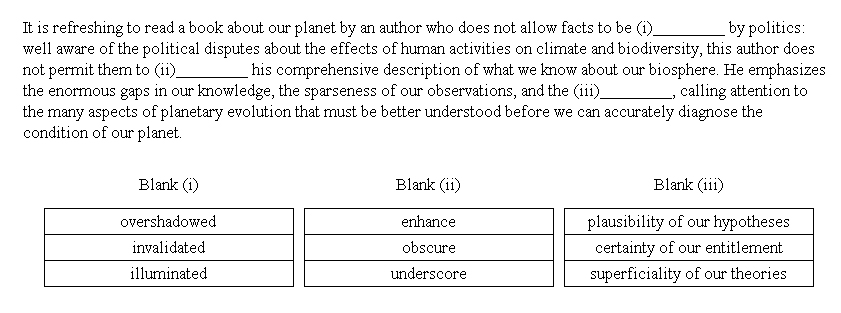
The author is arguing that politics get in the way of unbiased scientific examination of climate change. Blank (i) implies that often politics is given more weight more than science, so the right word is “overshadowed.” Blank (ii) continues this idea and claims that politics often hides scientific discovery, so the right word is “obscure.” Finally, blank (iii) comes after two synonymous phrases: the “enormous gaps in our knowledge,” the “sparseness of our observations.” So, the right choice has to be another way to say that we don’t know enough – the “superficiality of our theories.”
Sentence Equivalence Questions
These questions give you a sentence with a key word or phrase missing and six possible answer choices. You have to pick the two answers that could complete the sentence and get the same meaning. You only get credit for the question if you find both correct answers.
To select an answer, click the checkbox next to it. If you misclick, click the checkbox again to uncheck it.
Want to improve your GRE score by 7+ points?
Check out our best-in-class online GRE prep program. We guarantee your money back if you don't improve your GRE score by 7 points or more.
PrepScholar GRE is entirely online, and it customizes your prep program to your strengths and weaknesses. We also feature 2,000 practice questions, official practice tests, 150 hours of interactive lessons, and 1-on-1 scoring and feedback on your AWA essays.
Check out our 5-day free trial now:
Here’s an example:
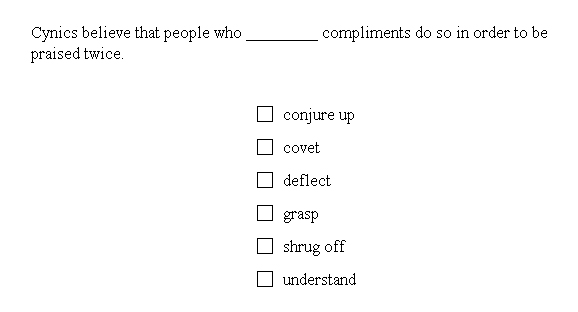
The question describes those who disingenuously fish for compliments by pretending to be self-effacing, so the right answers are “shrug off” and “deflect,” which mean to minimize accomplishments.
Reading Comprehension Questions
The GRE has about 10 passages: most are one paragraph long, and a few are several paragraphs long.
The passages feature formal writing from many disciplines – the humanities, the sciences, art, and business – but it’s not important to know the subject matter to answer the questions.
There are three possible Reading Comprehension question types:
- 1-answer multiple choice. You’ve seen this kind of Reading Comp question if you’ve taken any other standardized tests like the SAT or the ACT.
- Multiple-answer multiple choice. These have one or more correct answers, which ask you to select all the right answers in order to get credit for the question.
- Select-in-Passage. These ask you to pick a sentence in the passage itself in response to the question. (Remember: the paper test doesn’t have this question type.)
Here’s an example of 1-answer multiple choice question:

You have to figure out the main idea of the passage. The passage doesn’t address any of the first three answers. You could infer the fourth answer from the fact that the author is defending Glass’s use of popular music, but the passage doesn’t discuss Glass’s musical prominence. So the correct choice is the last answer. The passage directly says that even though he uses rock music, Glass’s “symphonies’ sound is distinctively his” – i.e. not a copy of someone else’s.
Multiple choice questions that have one or more answers are trickier. Since any and all of the answer choices could be correct, you have to carefully find all the answers that apply. The only way to get credit for the question is to pick all the correct answer choices, and only the correct answer choices.
Here’s an example of a multiple choice question that has more than one answer:

The question wants to know how the passage describes Glass’s music. Answer choice 1 is correct – Glass is “reviving” using popular music in classical music. Answer choice 2 is wrong – the passage specifically says that Glass’s music is “not a version of popular music.” Answer choice 3 is right as well – the passage implies that Glass has been doing this kind of fusion during his whole career as a composer. So to get this question right, you’d pick only answers 1 and 3 by clicking those checkboxes.
Finally, in select-in-passage questions, you have to highlight the appropriate sentence within the passage. That means you have to click the left half of the screen instead of on the right. Here is an example:

The question is asking for the sentence that describes two ways that rock and classical music can be combined. Only the last sentence of the passage talks about this – the author distinguishes between popular music composed for a classical audience, and also classical music composed for a rock music audience.

What Does the Verbal Reasoning Section Look Like?
Here is what the screen looks like during this section:
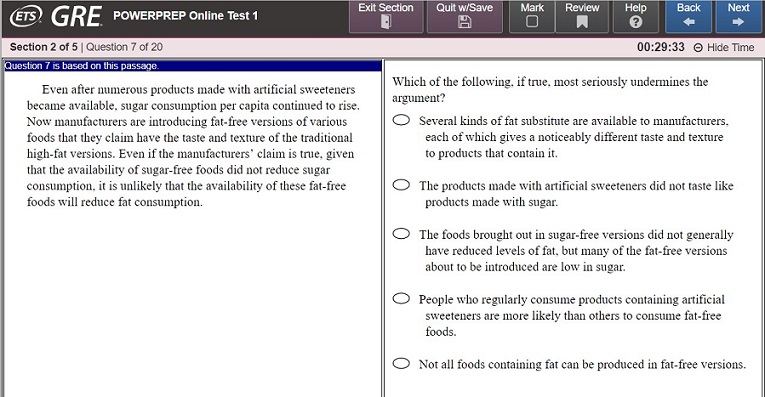
This section has the same countdown timer and “Help” button as the Analytical Writing section.
The “Exit Section” button leaves the section that you are working on, so don’t click it unless you are very sure that you are done with the section.
The “Next” and “Back” buttons take you to the next or previous question of the section. You can click these buttons even if you haven’t yet answered the question you’re on.
The “Mark” button flags a question for later, and the “Review” button takes you to another screen where you can see the status of each question. These are great tools, and I’ll explain how they work and when to use them later in the article.

GRE Test Pattern: Quantitative Reasoning
Each Quantitative section contains 8-9 Quantitative Comparison questions; 8-9 problem solving questions, where you solve word problems, geometry questions, or equations; and 3-4 Data Interpretation questions based on a graph or chart.
The sections evaluates your understanding of these math topics:
Arithmetic: integers, arithmetic operations, estimation, percent, ratio, rate, absolute value
Algebra: exponents; linear and quadratic equations; simultaneous equations and inequalities
Coordinate Geometry: graphs of functions, and lines
Geometry: lines, circles, triangles, polygons, three-dimensional figures; area, perimeter, volume, and angles
Data analysis: basic statistics (mean, median, mode, range, standard deviation), interpreting data tables and graphs, probability
Still, keep in mind that many questions aren’t really about brute force calculation, but are instead about using logic or estimates to solve a problem. Also, remember that you’ll have scratch paper and a built-in calculator to use whenever you want or need.
Quantitative Comparison Questions
These questions show you two quantities, and you have to determine if one is larger than the other, if they are equal, or if there’s not enough info to know.
The two values are always labeled Quantity A and Quantity B, and the four answer choices are always the same.
Here is an example:
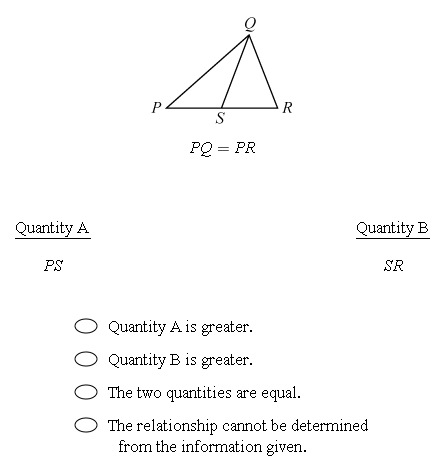
It makes more sense to use logic rather than geometry to answer this question. Line segment PS looks about the same length as line segment SR, but this doesn’t mean that they are actually equal. In fact, since we don’t know how big angles PQS and SQR are, we don’t know exactly where line QS intersects line PR. It could bisect it, or it could be closer to P or closer to R. So, the answer is the last choice – we don’t have enough information to know which line is longer.
Multiple-Choice Questions
Just like in the Verbal sections, there are two types multiple choice questions on the Quantitative sections. 1-answer multiple choice questions only have one right answer. Multiple-answer questions can have any number of correct answers – and you have to select them all to get credit for the question.
Here’s an example of a 1-answer multiple choice question
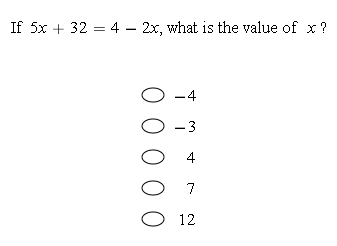
To solve for X, you have to manipulate this linear equation to get X alone on one side of the equals sign:
(5x + 32) + 2x = (4 – 2x) + 2x
7x + 32 = 4
(7x + 32) – 32 = (4) – 32
7x = -28
7x ÷ 7 = -28 ÷ 7
x = -4
To answer, click the bubble next to -4. If you misclick, simply click the bubble of the answer you do want instead.
Here is an example of the multiple-answer question:
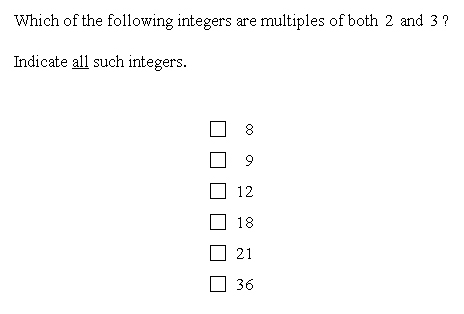
To solve this, divide each answer by 2 and 3. To answer, click the checkboxes next to the right answers (12, 18, 36). If you misclick, click on the checkbox again to clear it.
Numeric Entry Questions
Some questions ask you to type your solution into a blank space instead of giving you multiple answers to pick from. (But remember: on the paper test, for these questions you’ll fill your answer in on a number grid.)
In these questions, your answer is always an integer, decimal, or a fraction. If the answer is a fraction, you will fill in two blank spaces – the numerator and the denominator.
Here is an example of a Numeric Entry Question:

This question is asking you to do some arithmetic: (0.25 * 18) + (0.35 * 100). The answer is 39.5.
Note that the dollar sign is already written next to the answer blank. You just need to input the number itself, or click the “Transfer Display” button if you used the calculator to do the arithmetic. I’ll go over the calculator in more detail later in the article.
Data Interpretation Questions
Data Interpretation questions are either in multiple choice or numeric entry format, but they are grouped together by the graph or table they reference.
Depending on the type of graph used, you may be able to estimate the right answer.
Here’s an example of a problem that relies on data interpretation:

To solve this, you have to translate the percent of change to the real value that this percent of change represents.
Here, since Store P started with $800,000 in 2006, and from 2006 to 2007, Store P grew by 10%, that means that at the end of 2007, Store P had 110% of the dollar amount that it started with. So, ($800,000 * 1.1) = $880,000.
Now you do the same thing again with the next year. Store P started 2007 with $880,000, but then lost 10% of this value from 2007 to 2008. That means that at the end of 2008, Store P had 90% of the amount it had in 2007. So, ($880,000 * 0.9) = $792,000.
What Does the Quantitative Reasoning Section Look Like?
This is what the screen will look like when you’re on this section:
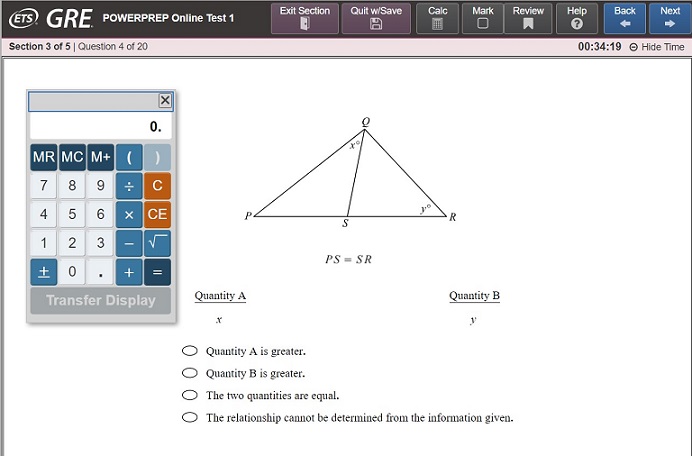
The “Exit Section,” “Help,” “Back,” and “Next” buttons and countdown timer are the same as the ones we already saw in the Analytical Writing and Verbal Reasoning sections.
The “Calc” button opens or closes the calculator. The calculator (seen in the above image) pops up in a separate window that you can reposition on the screen with your cursor. You can use the calculator either by clicking its buttons with your mouse, or by typing into it with your keyboard.
It has arithmetic functions (addition, subtraction, multiplication, division, and square root), parentheses to clarify the order of operations, and stored memory functions.
The calculator also has a “Transfer Display” button, which copies the number on the calculator display into the GRE test itself. You can use this to avoid careless transcription mistakes when answering Numeric Entry questions.

How to Use the GRE Exam Pattern to Your Benefit
Now let’s explore how you can use your understanding of the design of each section to improve your studying and test day performance!
Tips for Analytical Writing
When you’re studying and on test day, knowing how the GRE works really pays off. Here are our best strategies for the essay portion of the GRE exam pattern.
Remove the Element of Surprise
Since ETS has published all the possible prompts for both essays, there is no reason for you to be surprised by the essay topics on test day. Read all of the Issue statements and brainstorm evidence to argue the case one way or the other. Read all the and Argument paragraphs and categorize the type of errors they tend to make: logical leaps, erroneous inferences, shoddy use of evidence.
Plan Your Essays Out
During the test, use the supply of scratch paper from your test proctor to jot notes or briefly outline your essay before you start typing.
Take a Breather
Each essay task comes after a page of general instructions about the Analytical Writing section that you have to click to dismiss. Reading these instructions doesn’t count towards the 30 minutes you will have to spend on the essay. So if you need a second to collect your thoughts before starting the second essay, pause on this instruction page.
Tips for Verbal and Quantitative Reasoning
On these sections, you can and should take maximum advantage of the tools built into the GRE.
Practice Test-Day Conditions
In other words, don’t practice only on paper versions of the GRE. Since you’ll answer the questions by clicking your mouse on the computer screen, you won’t be able to use the strategy of crossing out wrong answers in your test booklet to narrow down the choices. Instead, get used to the computer setup by taking practice tests with ETS’s PowerPrep software.
Save the Hardest Questions for Later
The GRE lets you skip around within each section, mark questions for further attention, and to see your overall progress with the “Mark” and “Review” buttons.
The “Mark” button allows you to flag a question in order to come back to it later. The “Review” button takes you to a different screen where you can see the status of each question in the section you’re working on.
Here’s what the Review screen looks like:
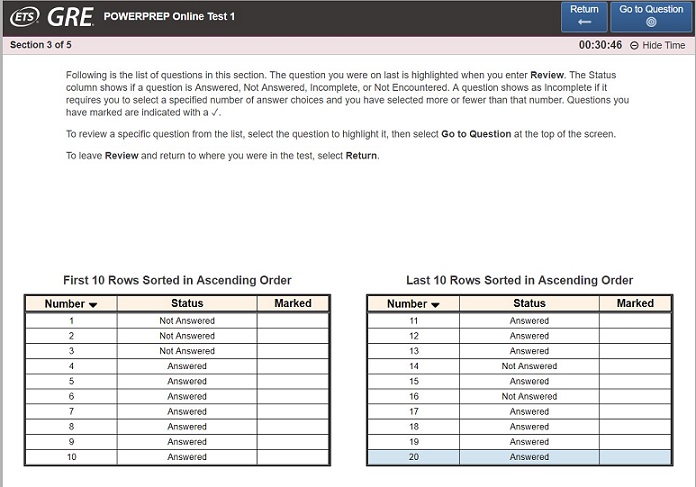
The Review screen lets you know whether you’ve answered, flagged, skipped, or not yet seen a particular question in the section. From here, you can either click “Return” to go back to the question you were on, or click “Go To Question” to type in the number of the question you’d like to revisit.
Sort Questions by Difficulty
You can sort the questions into four categories with the “Mark” and “Review” tools by labeling questions “Answered,” “Answered & Flagged,” “Skipped,” and “Skipped & Flagged.” This means that you can use the Review option to use your time efficiently.
For instance, you can Answer easy questions, Answer & Flag questions where you’ve eliminated 2 or more incorrect answer choices, Skip questions that seem confusing, and Skip & Flag questions that will require the most time to answer.
Don’t Guess On Geometry Questions
On the GRE, geometric figures aren’t drawn to scale. That means any pictures of triangles, polygons, and circles don’t necessarily reflect the dimensions they are supposed to have according to the problem.
So, you can’t use estimates to answer geometry-based questions, no matter what the picture illustrating the problem seems to suggest.
Smartly Estimate to-Scale Graphs and Charts
On the other hand, the GRE makes sure that any problem that uses a graph or a chart is drawn accurately to scale. This means problems that involve xy-planes, number lines, bar graphs, line graphs, or circle graphs are fair game for estimates.
So, for example, if a problem graphs a line, feel free to estimate its intercepts or slope.
Prevent Errors with the Built-In Calculator
Keep the “Transfer Display” calculator button in mind when working on the Numeric Entry questions. By automatically copying your result into the answer blank, you’ll avoid careless errors.
The Bottom Line: What the GRE Exam Pattern Means for You
Knowing the GRE test pattern and marking scheme of the will help you with studying and preparation, time management, and test-day stress.
The GRE has three section types: Analytical Writing, two sections of Verbal Reasoning, and two sections of Quantitative Reasoning. The computer-based test also includes an experimental section or a research section.
The Analytical Writing section is divided into two essay questions:
- “Analyze an Issue”: an essay convincing someone about your viewpoint
- “Analyze an Issue”: an essay finding holes in an existing argument
Verbal Reasoning sections consist of:
- 10 vocab questions: Text Completion (pick words to fit a sentence) and Sentence Equivalence (find synonyms to complete a sentence)
- 10 passage-based Reading Comprehension questions
Quantitative Reasoning sections consist of:
- 8-9 Quantitative Comparisons: compare two values
- 8-9 Problem Solving: word problems, geometry questions, equations
- 3-4 Data Interpretation: questions based on a graph or chart
- The questions test arithmetic, algebra, geometry, and data analysis.
The test screen features the following tools:
- For all sections:
- Countdown clock for the section you’re working on
- “Help”: bring up the instruction page
- “Exit Section”: to leave the section you are on early
- For Analytical Writing:
- A basic text editor featuring cut, paste, undo, and redo functions
- “Next”: take you to the next essay
- For Verbal and Quantitative Reasoning:
- “Next” and “Back”: go to the next or previous question
- “Mark”: flag a question in order to come back to it later
- “Review”: show your section progress
- For Quantitative Reasoning:
- “Calc”: bring up the calculator
- “Transfer Display”: copy the calculator’s display onto the GRE
Finally, remember the following tips on how to best use the GRE exam pattern:
- ETS has published every possible essay prompt, so prep them ahead of time.
- Use scratch paper to outline your essay before you start typing.
- Use instruction page to clear your mind before starting a new section.
- Use the “Mark” and “Review” tools to sort questions into categories and then work on them in ascending order of difficulty.
- Estimate answers on questions that use xy-plane graphs, bar graphs, line graphs, or circle graphs, since they are drawn to scale.
- Use the “Transfer Display” calculator button to avoid careless errors.
What’s Next?
Looking to learn more about the GRE marking scheme? Check out our guides to how the exam is scored, the GRE score range, and average GRE scores.
If you’re ready to sign up for the test, check out the GRE test date schedule and follow along with our full guide to registration.
Ready to improve your GRE score by 7 points?
We've written a eBook about the top 5 strategies you must be using to have a shot at improving your GRE score.
Download it for free now:

